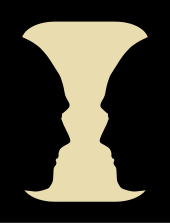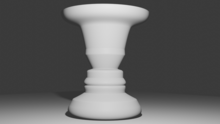229:
220:"figure" and not the "ground". However, when the contours are not so unequal, ambiguity starts to creep into the previously simple inequality, and the brain must begin "shaping" what it sees; it can be shown that this shaping overrides and is at a higher level than feature recognition processes that pull together the face and the vase images – one can think of the lower levels putting together distinct regions of the picture (each region of which makes sense in isolation), but when the brain tries to make sense of it as a whole, contradictions ensue, and patterns must be discarded.
674:
122:
25:
168:
179:. One element of Rubin's research may be summarized in the fundamental principle, "When two fields have a common border, and one is seen as figure and the other as ground, the immediate perceptual experience is characterized by a shaping effect which emerges from the common border of the fields and which operates only on one field or operates more strongly on one than on the other".
187:
The visual effect generally presents the viewer with two shape interpretations, each of which is consistent with the retinal image, but only one of which can be maintained at a given moment. This is because the bounding contour will be seen as belonging to the figure shape, which appears interposed
219:
and relationships. If one object surrounds another object, the surrounded object is seen as figure, and the presumably further away (and hence background) object is the ground, and reversed. This makes sense, since if a piece of fruit is lying on the ground, one would want to pay attention to the
252:
used on occasion). The picture should be "flat" and have little (if any) texture to it. The stereotypical example has a vase in the center, and a face matching its contour (since it is symmetrical, there is a matching face on the other side).
175:
Rubin presented in his doctoral thesis (1915) a detailed description of the visual figure-ground relationship, an outgrowth of the visual perception and memory work in the laboratory of his mentor,
383:
305:
188:
against a formless background. If the latter region is interpreted instead as the figure, then the same bounding contour will be seen as belonging to it.
358:"Vase or face? A neural correlates of shape-selective grouping processes in the human brain." Uri Hasson, Talma Hendler, Dafna Ben Bashat, Rafael Malach.
157:
The depicted version of Rubin's vase can be seen as the black profiles of two people looking towards each other or as a white vase, but not both.
380:
309:
420:
208:, in which the overall picture determines its mental interpretation, rather than the net effect of the individual pieces, influenced the
228:
291:
196:
These types of stimuli are both interesting and useful because they provide an excellent and intuitive demonstration of the
89:
61:
347:
334:
108:
648:
68:
413:
197:
46:
75:
42:
784:
406:
57:
603:
433:
160:
Another example of a bistable figure Rubin included in his Danish-language, two-volume book was the
717:
709:
281:
Rubin, E. (1915). Synsoplevede figurer: Studier i psykologisk analyse . Gyldendal, Nordisk forlag.
488:
35:
573:
523:
233:
483:
176:
743:
608:
583:
548:
392:
8:
653:
513:
508:
473:
248:
match seamlessly the contours of another picture (sometimes the same picture; a practice
215:
Normally the brain classifies images by which object surrounds which – establishing
663:
82:
673:
543:
518:
498:
209:
694:
748:
568:
503:
374:
343:
330:
241:
201:
758:
628:
598:
588:
553:
429:
205:
763:
643:
638:
623:
538:
458:
387:
141:
658:
633:
613:
593:
493:
468:
204:. Rubin's figure–ground distinction, since it involved higher-level cognitive
778:
533:
478:
161:
558:
528:
398:
245:
148:
578:
355:, William H. Ittelson. 1969, Springer Publishing Company, LOCCCN 60-15818
249:
151:
701:
563:
448:
262:
121:
725:
463:
232:
Water sculpture featuring a reverse profile of 19th c. abolitionist
24:
753:
453:
216:
145:
688:
364:, Vol 13(6), Aug 2001. pp. 744–753. ISSN 0898-929X (Print)
142:
ambiguous or bi-stable (i.e., reversing) two-dimensional forms
167:
292:"Looking back: Figure and ground at 100 | The Psychologist"
342:, Nicholas Wade. 1982 Routledge & Kegan Paul Ltd.
212:, who discovered many similar percepts themselves.
49:. Unsourced material may be challenged and removed.
329:, John M. Kennedy. 1974, Jossey-Bass Publishers,
776:
414:
428:
240:The distinction is exploited by devising an
421:
407:
109:Learn how and when to remove this message
16:Optical illusion developed by Edgar Rubin
227:
166:
120:
340:The art and science of visual illusions
777:
402:
47:adding citations to reliable sources
18:
395:The Rubin's vase before Rubin (fr)
200:distinction the brain makes during
13:
327:A Psychology of Picture Perception
320:
14:
796:
368:
362:Journal of Cognitive Neuroscience
672:
23:
223:
34:needs additional citations for
375:Rubin's People Inside the Wall
298:
284:
275:
191:
1:
268:
182:
144:developed around 1915 by the
377:People trapped inside a Wall
7:
256:
10:
801:
393:Rubin has invented nothing
171:A 3D model of a Rubin vase
125:A version of Rubin's vase.
736:
681:
670:
441:
381:Illusionworks.com article
236:in the black granite area
140:) is a famous example of
710:Ascending and Descending
132:(sometimes known as the
353:Visual Space Perception
237:
234:William Lloyd Garrison
172:
126:
231:
210:Gestalt psychologists
170:
124:
744:Accidental viewpoint
43:improve this article
649:Vertical–horizontal
749:Auditory illusions
544:Impossible trident
386:2013-01-20 at the
238:
177:Georg Elias Müller
173:
138:figure–ground vase
127:
785:Optical illusions
772:
771:
764:Temporal illusion
759:Tactile illusions
729:(2015 photograph)
430:Optical illusions
242:ambiguous picture
202:visual perception
119:
118:
111:
93:
792:
676:
629:Schroeder stairs
604:Peripheral drift
599:Penrose triangle
423:
416:
409:
400:
399:
314:
313:
308:. Archived from
302:
296:
295:
288:
282:
279:
206:pattern matching
114:
107:
103:
100:
94:
92:
51:
27:
19:
800:
799:
795:
794:
793:
791:
790:
789:
775:
774:
773:
768:
732:
682:Popular culture
677:
668:
639:Spinning dancer
459:Ambiguous image
437:
427:
388:Wayback Machine
371:
323:
321:Further reading
318:
317:
306:"Figure/Ground"
304:
303:
299:
290:
289:
285:
280:
276:
271:
259:
226:
194:
185:
115:
104:
98:
95:
52:
50:
40:
28:
17:
12:
11:
5:
798:
788:
787:
770:
769:
767:
766:
761:
756:
751:
746:
740:
738:
734:
733:
731:
730:
722:
721:(1961 drawing)
714:
713:(1960 drawing)
706:
698:
691:
685:
683:
679:
678:
671:
669:
667:
666:
661:
656:
651:
646:
641:
636:
634:Shepard tables
631:
626:
621:
616:
611:
606:
601:
596:
594:Penrose stairs
591:
586:
581:
576:
571:
566:
561:
556:
551:
546:
541:
536:
531:
526:
521:
516:
511:
506:
501:
496:
491:
489:Checker shadow
486:
481:
476:
471:
469:Autostereogram
466:
461:
456:
451:
445:
443:
439:
438:
426:
425:
418:
411:
403:
397:
396:
390:
378:
370:
369:External links
367:
366:
365:
359:
356:
350:
337:
322:
319:
316:
315:
312:on 2002-12-24.
297:
283:
273:
272:
270:
267:
266:
265:
258:
255:
225:
222:
193:
190:
184:
181:
117:
116:
31:
29:
22:
15:
9:
6:
4:
3:
2:
797:
786:
783:
782:
780:
765:
762:
760:
757:
755:
752:
750:
747:
745:
742:
741:
739:
735:
728:
727:
723:
720:
719:
715:
712:
711:
707:
704:
703:
699:
697:
696:
692:
690:
687:
686:
684:
680:
675:
665:
662:
660:
657:
655:
652:
650:
647:
645:
642:
640:
637:
635:
632:
630:
627:
625:
622:
620:
617:
615:
612:
610:
607:
605:
602:
600:
597:
595:
592:
590:
587:
585:
582:
580:
577:
575:
572:
570:
567:
565:
562:
560:
557:
555:
552:
550:
547:
545:
542:
540:
537:
535:
532:
530:
527:
525:
524:Fraser spiral
522:
520:
517:
515:
512:
510:
507:
505:
502:
500:
497:
495:
492:
490:
487:
485:
482:
480:
477:
475:
472:
470:
467:
465:
462:
460:
457:
455:
452:
450:
447:
446:
444:
440:
435:
431:
424:
419:
417:
412:
410:
405:
404:
401:
394:
391:
389:
385:
382:
379:
376:
373:
372:
363:
360:
357:
354:
351:
349:
348:0-7100-0868-6
345:
341:
338:
336:
335:0-87589-204-3
332:
328:
325:
324:
311:
307:
301:
293:
287:
278:
274:
264:
261:
260:
254:
251:
247:
243:
235:
230:
221:
218:
213:
211:
207:
203:
199:
198:figure–ground
189:
180:
178:
169:
165:
163:
162:Maltese cross
158:
155:
153:
150:
147:
143:
139:
135:
131:
123:
113:
110:
102:
99:November 2015
91:
88:
84:
81:
77:
74:
70:
67:
63:
60: –
59:
55:
54:Find sources:
48:
44:
38:
37:
32:This article
30:
26:
21:
20:
724:
716:
708:
700:
695:Trompe-l'œil
693:
618:
559:Lilac chaser
529:Gravity hill
361:
352:
339:
326:
310:the original
300:
286:
277:
239:
224:Construction
214:
195:
186:
174:
159:
156:
149:psychologist
137:
133:
130:Rubin's vase
129:
128:
105:
96:
86:
79:
72:
65:
58:"Rubin vase"
53:
41:Please help
36:verification
33:
705:(1864 book)
609:Poggendorff
584:Oppel-Kundt
579:Necker cube
574:Müller-Lyer
549:Irradiation
250:M.C. Escher
192:Explanation
152:Edgar Rubin
702:Spectropia
619:Rubin vase
569:McCollough
564:Mach bands
514:Ehrenstein
509:Ebbinghaus
474:Barberpole
449:Afterimage
269:References
263:Pareidolia
183:The effect
134:Rubin face
69:newspapers
754:Illusions
726:The dress
718:Waterfall
519:Flash lag
499:Cornsweet
484:Café wall
464:Ames room
442:Illusions
779:Category
504:Delboeuf
454:Ambigram
384:Archived
257:See also
246:contours
244:, whose
737:Related
664:Zöllner
654:White's
589:Orbison
554:Jastrow
136:or the
83:scholar
689:Op art
644:Ternus
624:Sander
539:Hering
479:Bezold
346:
333:
146:Danish
85:
78:
71:
64:
56:
659:Wundt
614:Ponzo
494:Chubb
217:depth
90:JSTOR
76:books
534:Grid
434:list
344:ISBN
331:ISBN
62:news
45:by
781::
164:.
154:.
436:)
432:(
422:e
415:t
408:v
294:.
112:)
106:(
101:)
97:(
87:·
80:·
73:·
66:·
39:.
Text is available under the Creative Commons Attribution-ShareAlike License. Additional terms may apply.


